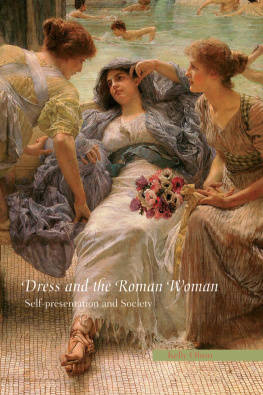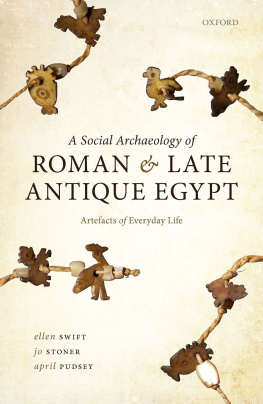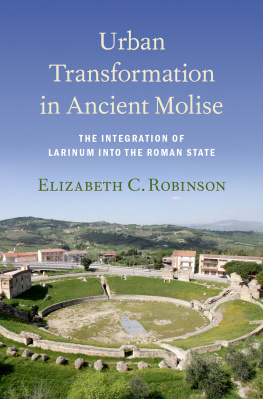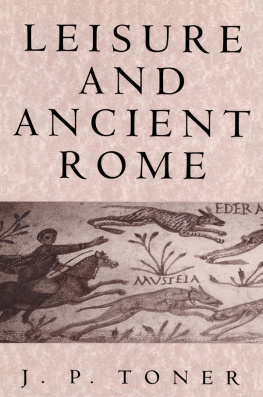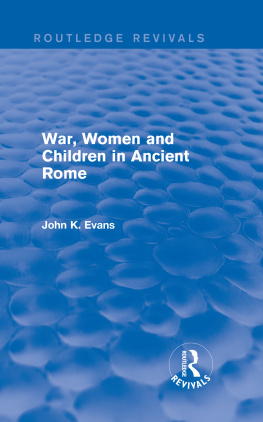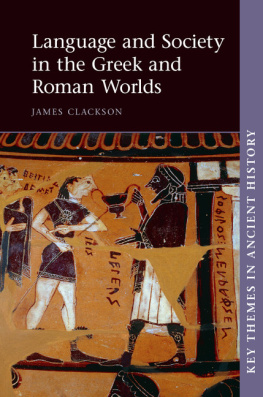DRESS AND THE ROMAN WOMAN
In ancient Rome, the subtlest details in dress helped to distinguish between levels of social and moral hierarchy. Clothes were a key part of the sign systems of Roman civilization a central aspect of its visual language, for women as well as men.
This engaging book collects and examines artistic evidence and literary references to female clothing, cosmetics and ornament in Roman antiquity, deciphering their meaning and revealing what it meant to be an adorned woman in Roman society.
Cosmetics, ornaments and fashion were often considered frivolous, wasteful or deceptive, which reflects ancient views about the nature of women. However, Kelly Olson uses literary evidence to argue that women often took pleasure in fashioning themselves, and many treated adornment as a significant activity, enjoying the social status, influence, and power that it signified.
This study makes an important contribution to our knowledge of Roman women and is essential reading for anyone interested in ancient Roman life.
Kelly Olson (PhD, University of Chicago) is associate professor at the University of Western Ontario, Canada. Her research interests are in the areas of Roman society and culture, and she has published numerous book chapters and articles on Roman women and ancient clothing.
DRESS AND THE
ROMAN WOMAN
Self-presentation and society
Kelly Olson
First published in 2008
by Routledge
2 Park Square, Milton Park,
Abingdon, Oxon OX14 4RN
Simultaneously published in the USA and Canada
by Routledge
711 Third Avenue,
New York, NY 10017
Routledge is an imprint of the Taylor & Francis Group, an informa business
2008 Kelly Olson
Typeset in Times New Roman by
Book Now Ltd, London
All rights reserved. No part of this book may be
reprinted or reproduced or utilized in any form or by any
electronic, mechanical, or other means, now known or hereafter
invented, including photocopying and recording, or in
any information storage or retrieval system, without
permission in writing from the publishers.
British Library Cataloguing in Publication Data
A catalogue record for this book is available from the British Library
Library of Congress Cataloguing in Publication Data
A catalog record for this book has been requested
ISBN13: 9780415414760 (pbk)
ISBN13: 9780415414753 (hbk)
ISBN13: 9780203927625 (ebk)
MEO PATRUO
Thomas Lyal Olson
It is only shallow people who do not judge by appearances.
The true mystery of the world is the visible, not the invisible.
Oscar Wilde, The Picture of Dorian Grey
Frontis nulla fides.
There is no faithfulness in appearance.
Juv. 2.8
CONTENTS
FIGURES
ACKNOWLEDGMENTS
Many people have provided comments on this manuscript, from its first draft as a dissertation to the finished project. I wish especially to thank Shadi Bartsch, Michael Dewar, David Lamari, Bonnie MacLachlan, James Miller, Ingrid Rowland, Peter White, and especially Richard Saller for his patience and insight. Gloria Ferrari Pinney taught me much about being a scholar and teacher; Charles Leslie Murison was generous with his expert advice on the manuscript. I owe Keith Bradley an enormous debt of gratitude for his tremendous support over the years, both personal and scholarly. Of course, I absolve all those acknowledged here from any complicity in the mistakes which will inevitably remain.
Help with administrative and research concerns was generously provided by Kathleen Fox (Chicago) and Judy La Forme (London). Funding for the project and research trips to Rome were provided at various points in Chicago by the William Shorey and Ryerson fellowships; and in London by the University of Western Ontario's Arts, Humanities, and Social Sciences Fund. Photos were provided by Art Resource, New York; the Deutsches Archologisches Institut; and the Raleigh, North Carolina Museum of Art. Line drawings were rendered by the talented and indomitable Chiara Capozzi. Translations throughout are from the Loeb Classical Library, with minor adjustments, with a few exceptions; translations of Tertullian and Jerome are from Roberts and Donaldson (1885) and Wace and Schaff (1893) respectively (again with minor adjustments). All translations of Nonius, Festus, and Servius are my own.
My family was also a big part of this project. My husband David, my mother Norma, and my daughters Katharine and Isabella provided endless love and assistance. My uncle T. L. Olson gave me unflagging encouragement from the very inception of my academic career, and it is to him that this book is dedicated.
K. Olson
London, Ontario, Canada 2007
ABBREVIATIONS
Abbreviations of journal titles are taken from L'Anne Philologique. Abbreviations of ancient authors and their works are taken from the Oxford Latin Dictionary.
CIL | Corpus Inscriptionum Latinarum (1863), Berlin: G. Reiner. |
Edict. | Edict of Diocletian (E. Graser [ed.] [1940] The Edict of Diocletian on Maximum Prices, in Frank [1940], 307421). |
Friedlnder
Sittensg. | Friedlnder, L. (191921) Darstellungen aus der Sittengeschichte Roms, 4 vols., 9th/10th rev. edn, Leipzig: S. Hirzel. |
ILS | Dessau, H. (18921916) Inscriptiones Latinae Selectae, 3 vols. Berlin: Weidemann. |
Paul. Sent | Riccobono, S. (ed.) (19689) Fontes Iuris Romani Antejustiniani, vol. ii: 319417, Florence: G. Barbra. |
PIR | Stein, A. and Peterson, L. (eds.) (195266) Prosopographia Imperii Romani, Berlin: De Gruyter. |
RE | Pauly, A., C. Walz, and W. S. Teuffel (eds.) (18941978) Real-Encyclopdie der classischen Altertumswissenschaft, Stuttgart: J. B. Metzler. |
ILLRP | Degrassi, A. (ed.) (1963, 1965) Inscriptiones Latinae Liberae Reipublicae, Florence: La Nuova Italia. |
PCG | Cassel, R. and Austin, C. (eds.) (1983) Poetae Comici Graeci, Berlin: De Gruyter. |
TLL | Thesaurus Linguae Latinae (1900), Leipzig: Teubner. |
INTRODUCTION
The importance of clothing
In 1976 a scholar of medieval history wrote that the history of fashion had derived its flavoring of economic and social significance only from the easy pickings of literary quotation or from an added dash of amateur psychology (Harte 1976: 140). It is less necessary now than it was three decades ago to justify writing cultural history, but nevertheless prejudices remain, especially in traditional fields. Is clothing worthy of serious scholarly investigation? In answer I would argue that, as has become evident in countless historical and sociological studies, clothing is important to a society's sense of itself. Clothing, for instance, relates to gendered behavioral ideals: women's clothing has often encapsulated cultural anxiety over gender, embodying both women's model characteristics and ideal relations between the sexes.

